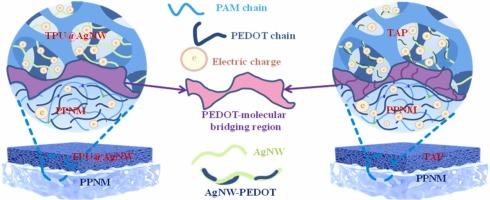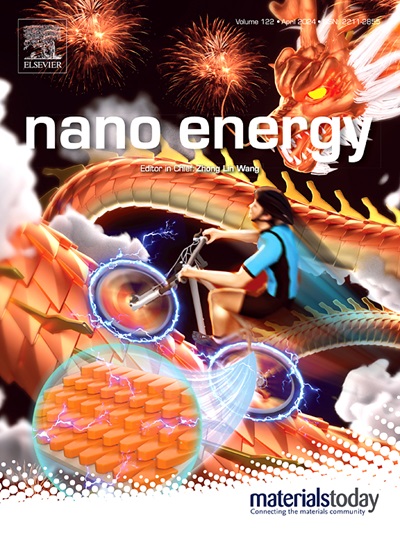PEDOT-molecular bridging foam-hydrogel based wearable triboelectric nanogenerator for energy harvesting and sensing
IF 16.8
1区 材料科学
Q1 CHEMISTRY, PHYSICAL
引用次数: 0
Abstract
Conductive hydrogels, due to their adjustable flexibility and conductivity, present considerable advantages in tackling the bottleneck issues associated with electron transfer in wearable electronic devices. However, during the deformation process, achieving effective electron transfer between the hydrogel electrode and the adjacent frictional piezoresistive sensing layer, as well as effective transmission within the hydrogel electrode itself, remains a significant challenge. Herein, PEDOT molecular bridging is proposed to establish an efficient connection between hydrogel electrode and the adjacent layer. Polyacrylamide integrated with PEDOT interpenetrating network-based hydrogel (PPNM) is prepared as electrode through synergistic dual-crosslinking. A repetitive vacuum-assisted dip-coating technique is employed to modify TPU foam scaffolds with silver nanowire (AgNW) and PPNM, resulting in TPU@AgNW@PPNM foam (TAP) with a three-dimensional dual-conductive network as the adjacent frictional piezoresistive sensing layer. By tightly integrating TAP with PPNM, a mutual PEDOT-bridging between TAP and PPNM is established. Importantly, the interface remains intact and ensures stable electron transmission even under significant stretching and bending conditions. The piezoresistive sensor and triboelectric nanogenerator assembled based on TAP and PPNM exhibited an enhanced sensitivity of 27.8 kPa−1 and an output power density of 3.1 mW m−2, respectively. This innovative solution effectively addresses the critical issue of electronic transfer between the electrode layer and the adjacent layer in wearable electronic devices, while also mitigating the problems related to the rigidity of electrodes that can impact the flexibility and comfort of wearable devices.

pedot -基于分子桥接泡沫水凝胶的可穿戴摩擦电纳米发电机,用于能量收集和传感
导电性水凝胶由于其可调节的柔韧性和导电性,在解决与可穿戴电子设备中电子转移相关的瓶颈问题方面表现出相当大的优势。然而,在变形过程中,如何在水凝胶电极和相邻的摩擦压阻传感层之间实现有效的电子传递,以及在水凝胶电极内部实现有效的电子传输,仍然是一个重大的挑战。本文提出利用PEDOT分子桥接技术在水凝胶电极与相邻层之间建立有效的连接。采用协同双交联法制备了与PEDOT互穿网络水凝胶(PPNM)集成的聚丙烯酰胺作为电极。采用重复真空辅助浸涂技术,用银纳米线(AgNW)和PPNM对TPU泡沫支架进行改性,得到了以三维双导电网络为相邻摩擦压阻传感层的TPU@AgNW@PPNM泡沫(TAP)。通过将TAP与PPNM紧密集成,在TAP与PPNM之间建立了相互的pedot桥接。重要的是,界面保持完整,即使在明显的拉伸和弯曲条件下也能确保稳定的电子传输。基于TAP和PPNM组装的压阻式传感器和摩擦电纳米发电机的灵敏度提高了27.8 kPa-1,输出功率密度提高了3.1 mW - m-2。这种创新的解决方案有效地解决了可穿戴电子设备中电极层和相邻层之间电子传输的关键问题,同时也减轻了与电极刚性相关的问题,这些问题可能影响可穿戴设备的灵活性和舒适性。
本文章由计算机程序翻译,如有差异,请以英文原文为准。
求助全文
约1分钟内获得全文
求助全文
来源期刊

Nano Energy
CHEMISTRY, PHYSICAL-NANOSCIENCE & NANOTECHNOLOGY
CiteScore
30.30
自引率
7.40%
发文量
1207
审稿时长
23 days
期刊介绍:
Nano Energy is a multidisciplinary, rapid-publication forum of original peer-reviewed contributions on the science and engineering of nanomaterials and nanodevices used in all forms of energy harvesting, conversion, storage, utilization and policy. Through its mixture of articles, reviews, communications, research news, and information on key developments, Nano Energy provides a comprehensive coverage of this exciting and dynamic field which joins nanoscience and nanotechnology with energy science. The journal is relevant to all those who are interested in nanomaterials solutions to the energy problem.
Nano Energy publishes original experimental and theoretical research on all aspects of energy-related research which utilizes nanomaterials and nanotechnology. Manuscripts of four types are considered: review articles which inform readers of the latest research and advances in energy science; rapid communications which feature exciting research breakthroughs in the field; full-length articles which report comprehensive research developments; and news and opinions which comment on topical issues or express views on the developments in related fields.
文献相关原料
公司名称
产品信息
麦克林
ammonium persulfate (APS)
阿拉丁
N, N'-methylenebisacrylamide
阿拉丁
N-hydroxymethylacrylamide
阿拉丁
acrylamide (AM)
阿拉丁
poly(3,4-ethylenedioxythiophene)-poly(styrenesulfonate)
阿拉丁
acrylamide (AM)
 求助内容:
求助内容: 应助结果提醒方式:
应助结果提醒方式:


